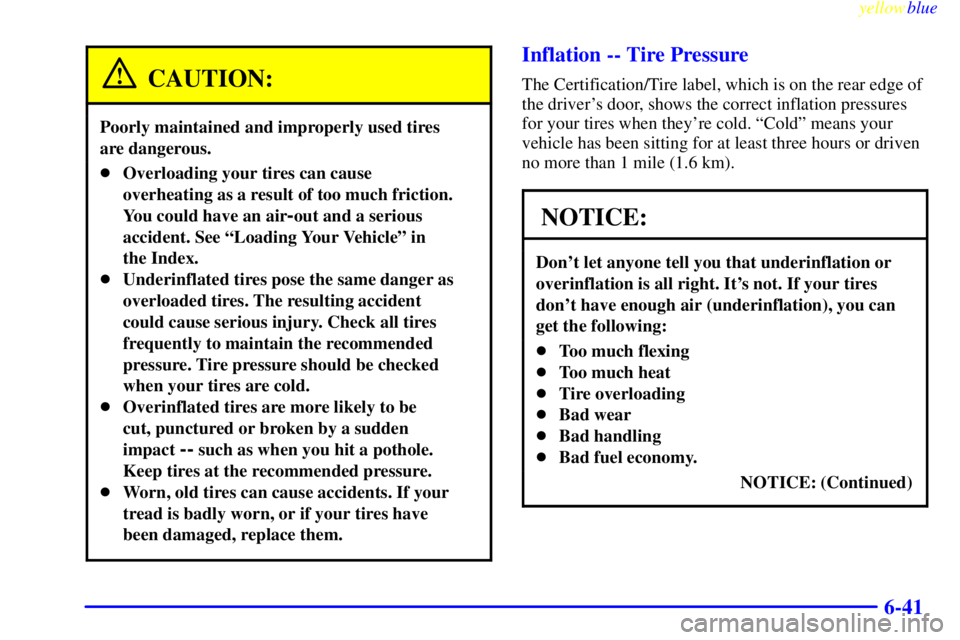Page 238 of 398

yellowblue
5-22 Removing the Spare Tire and Tools
Your spare tire is stored underneath the rear of your
vehicle. You will use the ratchet and extension to lower
the spare tire.
A flat rear tire reduces clearance to remove the spare
tire. If there is less than 12 inches (30.48 cm) between
the ground and the rear bumper or any trailer hitch, jack
up the vehicle until the flat tire is off the ground. (See
ªRemoving the Flat Tireº and ªInstalling the Spare
Tire,º Steps 4 through 8, in this section.)Unless your vehicle has a flat rear tire, do not remove or
restore a tire from/to a storage position under the vehicle
while the vehicle is supported by a jack. Always tighten
the tire fully against the underside of the vehicle
when restoring.
If you have a vehicle which was completed from a cab
and chassis, refer to the information from the body
supplier/installer.
The spare tire is a full
-size tire, like the other tires on
your vehicle.
For cargo vans, and all
passenger vans except those
with the 15
-passenger
seating arrangement, the
jack is secured in the rear
passenger side corner of
the vehicle.
Remove the retaining wing bolt and lift it off the
mounting bracket. Set the jack and jacking equipment
near the flat tire.
Page 239 of 398
yellowblue
5-23
For vans with the 15-passenger seating arrangement,
the jack is secured on the rear passenger side floor of
the vehicle.
Remove the retaining wing bolt and lift it out of the
mounting bracket. Set the jack and jacking equipment
near the flat tire.
The ratchet has a DOWN side and an UP side.
Attach the ratchet, with the DOWN side facing you, to
the extension. The extension has a socket end and a flat
chisel end.
Put the flat end of the extension on an angle through the
hole in the rear door frame, above the bumper. Be sure
the flat end connects into the hoist shaft.
Page 240 of 398
yellowblue
5-24
Turn the ratchet counterclockwise to lower the spare tire
to the ground. If you are changing a flat rear tire and the
vehicle is already jacked up, use the jack handle and
extension to hook the cable. Then pull the spare from
beneath the vehicle. If the retainer pulls out, hook the
inside of the wheel and pull the spare tire out from under
the vehicle.
When the tire has been lowered, tilt the retainer at the
end of the cable and pull it through the wheel opening.
NOTICE:
To help avoid vehicle damage, do not drive the
vehicle before the cable is restored.
Page 243 of 398
yellowblue
5-27
3. Remove the center cap.
Removing the Flat Tire and Installing the
Spare Tire
1. With the DOWN side facing you, use the ratchet and
socket to loosen all the wheel nuts. Don't remove
them yet.
Page 246 of 398
yellowblue
5-30
5. Raise the vehicle by turning the ratchet clockwise.
Make sure the UP mark faces you. Raise the vehicle
far enough off the ground so there is enough room
for the spare tire to fit.
6. Remove all the wheel
nuts, and take off the
flat tire.
7. Remove any rust or dirt
from the wheel bolts,
mounting surfaces and
spare wheel.
Page 249 of 398
yellowblue
5-33
NOTICE:
Improperly tightened wheel nuts can lead to
brake pulsation and rotor damage. To avoid
expensive brake repairs, evenly tighten the wheel
nuts in the proper sequence and to the proper
torque specification.
11. Put the wheel cover back on, if you have one.
Remove any wheel blocks.
Remember that the jack, jacking equipment and tire
must be properly stored in their original storage
position before you begin driving again. The next
part will show you how.
Storing a Flat or Spare Tire and Tools
CAUTION:
Storing a jack, a tire or other equipment in the
passenger compartment of the vehicle could
cause injury. In a sudden stop or collision, loose
equipment could strike someone. Store all these
in the proper place.
1. Put the tire on the ground at the rear of the vehicle,
with the valve stem pointed down.
Page 251 of 398
yellowblue
5-35
4. Attach the ratchet, with the UP side facing you, to
the extension.5. Put the flat end of the extension on an angle through
the hole in the rear door frame, above the bumper.
6. Raise the tire fully against the underside of the
vehicle. Continue turning the ratchet/wheel wrench
until the tire is secure and the cable is tight. The
spare tire hoist cannot be overtightened.
Page 295 of 398

yellowblue
6-41
CAUTION:
Poorly maintained and improperly used tires
are dangerous.
�Overloading your tires can cause
overheating as a result of too much friction.
You could have an air
-out and a serious
accident. See ªLoading Your Vehicleº in
the Index.
�Underinflated tires pose the same danger as
overloaded tires. The resulting accident
could cause serious injury. Check all tires
frequently to maintain the recommended
pressure. Tire pressure should be checked
when your tires are cold.
�Overinflated tires are more likely to be
cut, punctured or broken by a sudden
impact
-- such as when you hit a pothole.
Keep tires at the recommended pressure.
�Worn, old tires can cause accidents. If your
tread is badly worn, or if your tires have
been damaged, replace them.
Inflation -- Tire Pressure
The Certification/Tire label, which is on the rear edge of
the driver's door, shows the correct inflation pressures
for your tires when they're cold. ªColdº means your
vehicle has been sitting for at least three hours or driven
no more than 1 mile (1.6 km).
NOTICE:
Don't let anyone tell you that underinflation or
overinflation is all right. It's not. If your tires
don't have enough air (underinflation), you can
get the following:
�Too much flexing
�Too much heat
�Tire overloading
�Bad wear
�Bad handling
�Bad fuel economy.
NOTICE: (Continued)